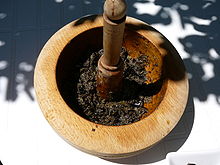|
Tapenade
Tapenade (French pronunciation: [tapəˈnad]; Occitan: tapenada [tapeˈnadɔ]) is a Provençal[1] name for a spread, condiment and culinary ingredient consisting of puréed or finely chopped olives, capers, and sometimes anchovies.[2] The name comes from the Provençal word for capers, tapenas (pronounced [taˈpenɔs]). It is a popular food in the south of France, where it is generally eaten as an hors d'œuvre spread on bread, with fish, in salads, and sometimes used to stuff poultry for the main course. History of similar dishes Olive-based dishes can be found in ancient times. For example, Olivarum conditurae in Columella's De re Rustica [3][4] and epityrum from Cato the Elder were Greek dips adopted by the Romans that included olives but also many ingredients like celery, leeks, rue, mint, wine and vinegar. Tapenade is based mainly on capers and olives.[1] According to the culinary works of Provençal chefs Jean-Baptiste Reboul and Charles Julliard, the tapenade was created in 1880 by chef Meynier of the restaurant La Maison Dorée in Marseille. He pounded together an equal amount (200 grams) of capers and black olives to garnish the hard-boiled egg halves, then incorporated anchovy fillets and marinated tuna (100 grams each). This condiment composition was then tied with a whisk after adding spices, pepper, olive oil, and two glasses of cognac.[5] PreparationThe base ingredients of tapenade are olives and capers.[1] The olives (most commonly black olive) and capers are chopped finely, crushed, or blended. Then olive oil is added gradually until the mixture becomes a paste.[6] In various regions, tapenade is often flavored differently, with other ingredients such as garlic, herbs, anchovies, lemon juice, or brandy.[7] Serving Tapenade may be used as part of an appetizer served as a topping on crusty bread or crudités. It can be an ingredient in salad, as shown in the image from a Provence restaurant. It may also be used as a condiment and in preparing fish dishes.[8] See alsoWikimedia Commons has media related to Tapenade. References
|
||||||||||||||
